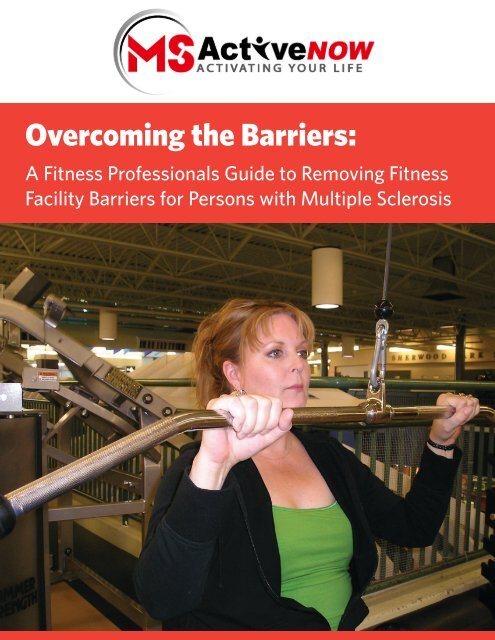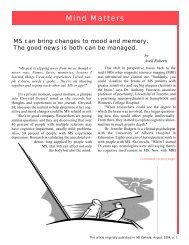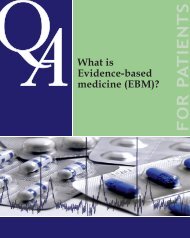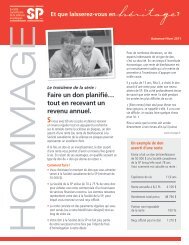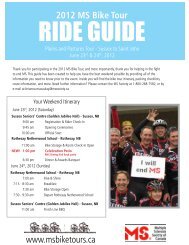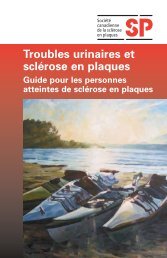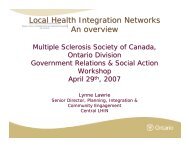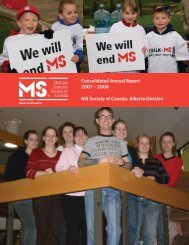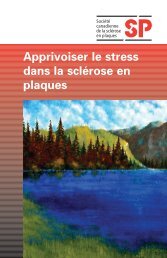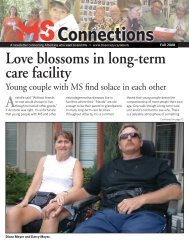Overcoming the Barriers - Multiple Sclerosis Society of Canada
Overcoming the Barriers - Multiple Sclerosis Society of Canada
Overcoming the Barriers - Multiple Sclerosis Society of Canada
You also want an ePaper? Increase the reach of your titles
YUMPU automatically turns print PDFs into web optimized ePapers that Google loves.
<strong>Overcoming</strong> <strong>the</strong> <strong>Barriers</strong>:<br />
A Fitness Pr<strong>of</strong>essionals Guide to Removing Fitness<br />
Facility <strong>Barriers</strong> for Persons with <strong>Multiple</strong> <strong>Sclerosis</strong>
OVERCOMING THE BARRIERS<br />
© MS <strong>Society</strong> <strong>of</strong> <strong>Canada</strong>, Alberta Division, 2009. All rights reserved. None <strong>of</strong> <strong>the</strong> contents may be<br />
produced in any form without prior written permission from <strong>the</strong> publisher.<br />
Written by: Keith Johnston, Garry Wheeler & Scott Rattray<br />
Design and publishing: Marcus Samuelson<br />
Printing: Priority Printing<br />
Front cover photo: Andrea Anderson at Millennium Place, Sherwood Park, Alberta<br />
Photo taken by: Darrel Gregory<br />
2 MS <strong>Society</strong> <strong>of</strong> <strong>Canada</strong>, Alberta Division
A Fitness Pr<strong>of</strong>essionals Guide<br />
Table <strong>of</strong> Contents<br />
MS ActiveNOW...........................................................................................................4<br />
Introduction..................................................................................................................4<br />
General <strong>Barriers</strong> to Participation.............................................................................5<br />
Tips for Interacting with Persons with MS...........................................................6<br />
Determining Accessibility <strong>of</strong> a Fitness Facility....................................................6<br />
7 Principles <strong>of</strong> Universal Design..............................................................................8<br />
Guidelines for Selecting Equipment.......................................................................9<br />
Tips for Adapting Exercise........................................................................................10<br />
MS Symptoms as a Barrier.......................................................................................12<br />
Five Suggestions for Making Your Facility a ‘Welcoming Facility’..................13<br />
Closing...........................................................................................................................13<br />
Need More Information............................................................................................14<br />
Resources......................................................................................................................14<br />
References....................................................................................................................15<br />
MS <strong>Society</strong> <strong>of</strong> <strong>Canada</strong>, Alberta Division<br />
3
OVERCOMING THE BARRIERS<br />
MS ActiveNOW<br />
MS ActiveNOW is a health promotion initiative for persons with multiple sclerosis (MS) designed to:<br />
• Increase awareness <strong>of</strong> <strong>the</strong> benefits <strong>of</strong> daily physical activity and exercise for persons with MS, caregivers, and<br />
providers in <strong>the</strong> health, fitness and lifestyle industry;<br />
• Help fitness providers design exercise programs for persons with MS, so that persons with MS may enjoy <strong>the</strong><br />
benefits <strong>of</strong> exercise safely and with confidence;<br />
• Increase access to active living and exercise opportunities in <strong>the</strong> community for persons with MS; and<br />
• Increase intention for physical activity and exercise in persons with MS.<br />
MS ActiveNOW uses a combination <strong>of</strong> information sessions and target audience specific materials in order to raise<br />
awareness and educate persons with MS, fitness and lifestyle pr<strong>of</strong>essionals and health pr<strong>of</strong>essionals with regard to <strong>the</strong><br />
role <strong>of</strong> exercise in symptom management <strong>of</strong> MS and to provide a guide for suitable exercises for persons with MS.<br />
Introduction<br />
Over <strong>the</strong> past 10 years, <strong>the</strong>re has been a noticeable shift in <strong>the</strong> understanding <strong>of</strong> disability and treatment <strong>of</strong> persons<br />
with disabilities. A medical-based model for service delivery has now given way to social models that place emphasis on<br />
health promotion and <strong>the</strong> prevention <strong>of</strong> secondary health conditions such as obesity, type II diabetes, and hypertension 1 .<br />
The medical viewpoint conceptualized problems as residing within <strong>the</strong> individual; that disabilities were difficulties or<br />
limitations. Contrary to this, <strong>the</strong> social model <strong>of</strong> disability views disability as a function <strong>of</strong> impairment and environment<br />
and also <strong>the</strong> concept <strong>of</strong> disability as a part <strong>of</strong>. What this means is that by engaging in physical activity within a<br />
welcoming, comfortable and accessible facility it can help to unlock or maximize a persons individual potential. In<br />
fact contrary to historical views or dogma, exercise and physical activity for persons with MS carriers <strong>the</strong> same health<br />
benefits as people without MS 2 .<br />
In <strong>the</strong> past, many people with disabilities, including persons living with MS, avoided using community fitness and<br />
recreation facilities due to a number <strong>of</strong> reasons or barriers. First, persons with MS were advised to avoid exercise due to<br />
<strong>the</strong> risks <strong>of</strong> elevated body temperature, physical exertion, fatigue, and unpredictability <strong>of</strong> <strong>the</strong> disease 3 . However, recent<br />
research has shown that exercise in moderation is beneficial and safe for individuals with MS and is now recognized as<br />
an important part <strong>of</strong> <strong>the</strong> care plan and symptom management for MS. Thus, <strong>the</strong> goal <strong>of</strong> exercise for persons with MS is<br />
to improve overall health and maintain function in order to maintain a self defined level <strong>of</strong> independence and quality <strong>of</strong><br />
life 4 .<br />
Second, barriers can exist that prevent a person with MS from fully participating in activities within fitness centres,<br />
whe<strong>the</strong>r <strong>the</strong>y are physical, psychological or social in nature. For example, facilities and programs designed to include<br />
persons with disabilities (including MS) still have limitations, as a facility may lack adequate access, ramps and<br />
accessible washrooms or change rooms 5 . As a result <strong>of</strong> <strong>the</strong>se limiting factors, many individuals with disabilities are<br />
looking to use a small number <strong>of</strong> specialized facilities and programs that are <strong>of</strong>ten operating at maximum capacity. The<br />
end result is an increased number <strong>of</strong> people waiting for access, but more importantly waiting to be physically active in<br />
general and not receiving <strong>the</strong> immediate and ongoing benefits <strong>of</strong> being physical active.<br />
Third, many fitness facility staff lack knowledge regarding helping people with disabilities become active or knowledge<br />
on specific disabilities. This lack <strong>of</strong> knowledge or awareness can ei<strong>the</strong>r be around understanding and knowing what<br />
MS is and <strong>the</strong> symptoms associated with it, or <strong>the</strong> impact that MS can have upon physical activity levels and intention<br />
4 MS <strong>Society</strong> <strong>of</strong> <strong>Canada</strong>, Alberta Division
A Fitness Pr<strong>of</strong>essionals Guide<br />
for physical activity. This in turn can create a barrier to participation as a person with MS may not feel comfortable in<br />
seeking <strong>the</strong> guidance or aid <strong>of</strong> <strong>the</strong> staff around program design and proper exercise principles.<br />
Finally, a potential perceived lack <strong>of</strong> social support or a sense <strong>of</strong> belonging may contribute to a lack <strong>of</strong> access. This<br />
barrier alone can be difficult to overcome, especially when a person with MS may not feel confident in <strong>the</strong>ir abilities to<br />
participate in physical activities or exercise programs.<br />
The intent <strong>of</strong> this brief guide is to provide fitness and lifestyle pr<strong>of</strong>essionals along with fitness and recreation facilities<br />
with key information on overcoming or removing <strong>the</strong> barriers to participation that persons with MS or o<strong>the</strong>r with<br />
disabilities may experience.<br />
General <strong>Barriers</strong> to Participation<br />
The community environment, specifically <strong>the</strong> community fitness and recreation centre can be a complex environment<br />
filled with many challenges for a person with MS. These challenges or barriers can be physical, social, psychological, or<br />
economic in nature. These barriers can ei<strong>the</strong>r be present singularly or in combination. Presented here are some <strong>of</strong> <strong>the</strong><br />
most common barriers experienced or discussed by persons with disabilities, including persons with MS.<br />
The Physical Environment<br />
• Lack <strong>of</strong> accessible design in <strong>the</strong> facility (i.e., accessible routes, ramps, washrooms, changing areas, etc.)<br />
• Lack <strong>of</strong> accessible design in equipment<br />
• Lack <strong>of</strong> transportation to and from facilities<br />
The Social Environment<br />
• Attitudes <strong>of</strong> o<strong>the</strong>r community members or users <strong>of</strong> <strong>the</strong> facility (i.e., discomfort, negative attitudes)<br />
• Attitudes <strong>of</strong> staff towards persons with disabilities<br />
• Facility staff lacking knowledge about MS and <strong>the</strong> special considerations around exercise<br />
Psychological <strong>Barriers</strong><br />
• Lack <strong>of</strong> confidence in abilities<br />
• Lack <strong>of</strong> knowledge about community resources (i.e., what is out <strong>the</strong>re and what is available)<br />
• Lack <strong>of</strong> skill with mobility aids (e.g., wheelchair, walker, cane, etc.)<br />
• Actual or perceived lack <strong>of</strong> social support or sense <strong>of</strong> belonging<br />
• Lack <strong>of</strong> knowledge about exercise techniques<br />
• Lack <strong>of</strong> knowledge about what special exercise considerations should be taken into account because <strong>of</strong> a persons’<br />
MS<br />
Economic <strong>Barriers</strong><br />
• Membership or facility access fees can prevent persons with MS from becoming active<br />
The aforementioned list is based upon a review <strong>of</strong> research literature into barriers to participation for persons with<br />
disabilities and direct conversations with persons with MS about <strong>the</strong>ir physical activity experiences using community<br />
fitness facilities 6,7,8 . Please note o<strong>the</strong>r barriers may exist that are not listed, if you require additional information or<br />
support in regards to a barrier that has been brought to your attention, please contact your local chapter <strong>of</strong> <strong>the</strong> MS<br />
<strong>Society</strong> <strong>of</strong> <strong>Canada</strong> for assistance (1-800-268-7528).<br />
MS <strong>Society</strong> <strong>of</strong> <strong>Canada</strong>, Alberta Division<br />
5
OVERCOMING THE BARRIERS<br />
Tips for Interacting with Persons with MS<br />
As mentioned earlier in this guide attitudinal barriers can affect motivation and intention to start or continue to access<br />
a community fitness or recreation facilities. Provided here are some general tips for interacting with persons with MS<br />
or for that matter any type <strong>of</strong> disability. Doing some <strong>of</strong> <strong>the</strong>se simple things can help to remove some <strong>of</strong> <strong>the</strong> real and<br />
perceived barriers people may face.<br />
• Always treat a person with MS or for that matter anyone with a disability with <strong>the</strong> same respect that you would<br />
extend to everyone else.<br />
• Use words that put <strong>the</strong> person first, referring to <strong>the</strong>m as a “person with multiple sclerosis’. Avoid using words like<br />
‘handicapped’, ‘crippled’, ‘wheelchair bound’, or ‘confined to a wheelchair’.<br />
• Don’t be afraid to <strong>of</strong>fer assistance to a person with a disability if you feel it might be helpful or necessary, but wait<br />
until your <strong>of</strong>fer is accepted before you help. As well, listen to any instructions that <strong>the</strong> person gives about <strong>the</strong> best<br />
way to assist <strong>the</strong>m.<br />
• When talking to with a person with MS, speak directly to <strong>the</strong>m ra<strong>the</strong>r than through a companion who may be with<br />
<strong>the</strong>m.<br />
• Let <strong>the</strong> person with MS make <strong>the</strong>ir own decisions regarding what <strong>the</strong>y can or cannot do. Do not impose limitations<br />
on someone else’s capabilities or interests. Be careful not to be overprotective.<br />
• Be considerate <strong>of</strong> <strong>the</strong> extra time it may take <strong>the</strong> person to get things done. Let <strong>the</strong> person set <strong>the</strong> pace.<br />
• Do not move a person’s wheelchair or mobility aid out <strong>of</strong> reach without <strong>the</strong>ir permission if <strong>the</strong>y have transferred<br />
onto a piece <strong>of</strong> equipment. A person’s wheelchair or mobility aid can be considered an extension <strong>of</strong> <strong>the</strong>ir body and<br />
should be treated as such.<br />
Determining Accessibility <strong>of</strong> a Fitness Facility<br />
Accessibility can be a large barrier to participation for a person with MS in deciding whe<strong>the</strong>r to start, continue with, or<br />
cease participating in physical activity and exercise. When thinking <strong>of</strong> accessibility people commonly think <strong>of</strong> issues<br />
related to building access and public spaces. Equipment can also play a very important role in determining accessibility.<br />
Presented here is a list <strong>of</strong> potential barriers to determine whe<strong>the</strong>r your fitness or recreation facility can meet <strong>the</strong> needs<br />
<strong>of</strong> persons with MS. In addition, this information can be used by a person with MS to decide whe<strong>the</strong>r your facility is <strong>the</strong><br />
right place for <strong>the</strong>m.<br />
Adaptability <strong>of</strong> exercise equipment<br />
Can <strong>the</strong> equipment be modified or adjusted to accommodate <strong>the</strong> needs <strong>of</strong> <strong>the</strong> person with MS? For example,<br />
cardiovascular equipment with removable middle consoles or adjustable seats are easier to get on and <strong>of</strong>f.<br />
Adaptability <strong>of</strong> exercise classes<br />
Do <strong>the</strong> fitness classes (i.e., cardio, yoga) at <strong>the</strong> fitness centre <strong>of</strong>fer choices in exercises, pace and intensity that include<br />
participants with a wide range <strong>of</strong> abilities? For example, could a person with MS participate in a Yoga or Tai Chi<br />
class while seated in a chair instead <strong>of</strong> standing or lying on <strong>the</strong> floor? A person with MS can and will still receive <strong>the</strong><br />
same health and exercise benefits as if <strong>the</strong>y were standing or lying 9 . In addition, <strong>the</strong> ability for <strong>the</strong> person with MS to<br />
select <strong>the</strong>ir own intensity and participation level will ensure that <strong>the</strong>y work within <strong>the</strong>ir abilities and ensure ongoing<br />
continuation in exercise and physical activity.<br />
6 MS <strong>Society</strong> <strong>of</strong> <strong>Canada</strong>, Alberta Division
A Fitness Pr<strong>of</strong>essionals Guide<br />
Design <strong>of</strong> activity spaces and placement <strong>of</strong> equipment<br />
Does <strong>the</strong> space between equipment at your fitness facility allow for ease <strong>of</strong> manoeuvring around, ei<strong>the</strong>r with mobility<br />
aids (i.e., wheelchairs, canes, walkers, scooters) or without? Is <strong>the</strong>re enough room for a person who uses a wheelchair<br />
(motorized and non-motorized) to move around with ease to allow <strong>the</strong>m to transfer on and <strong>of</strong>f equipment without<br />
assistance?<br />
An important feature that makes it possible for a person using a wheelchair, scooter, or o<strong>the</strong>r mobility aid to manoeuvre<br />
around independently is an accessible route. Without it your facility will not be usable by many people with mobility<br />
impairments. An accessible route is a clear path at least 36 inches wide with no steps or stairs.<br />
Most fitness facilities have rows <strong>of</strong> treadmills, exercise bikes, and o<strong>the</strong>r cardiovascular equipment grouped, usually very<br />
close toge<strong>the</strong>r. Many people with disabilities, including persons with MS can use much <strong>of</strong> this equipment, but given <strong>the</strong><br />
space restriction between pieces <strong>of</strong> equipment, access is <strong>of</strong>ten difficult. Although it is ideal to have 36 inches <strong>of</strong> clear<br />
floor space between each piece <strong>of</strong> equipment, this however may not be possible. Often <strong>the</strong> simplest strategy is to locate<br />
one <strong>of</strong> each type <strong>of</strong> equipment at <strong>the</strong> end <strong>of</strong> a row along <strong>the</strong> accessible route. A good rule <strong>of</strong> thumb is to plan a circle<br />
60 inches in diameter beside <strong>the</strong> exercise equipment with <strong>the</strong> circle overlapping <strong>the</strong> accessible route 10 . Therefore, if a<br />
person’s wheelchair or scooter can be parked perpendicularly to a piece <strong>of</strong> equipment, allowing o<strong>the</strong>r people to still pass<br />
by while <strong>the</strong> person is using <strong>the</strong> equipment and not feeling in <strong>the</strong> way.<br />
In terms <strong>of</strong> <strong>the</strong> placement <strong>of</strong> strength training equipment, it is important that any stand-alone equipment has adequate<br />
space on all sides. A good minimum space is 36 inches, but this is <strong>of</strong>ten not sufficient for many people. If possible,<br />
try to provide somewhere between 36 and 48 inches <strong>of</strong> clear floor area perpendicular to <strong>the</strong> equipment on any side 10 ,<br />
thus allowing for increased ease <strong>of</strong> transferring and providing easier access to pins or controls while still seated in <strong>the</strong>ir<br />
wheelchair. Note, some people who use wheelchairs prefer to transfer from <strong>the</strong>ir right, while o<strong>the</strong>rs from <strong>the</strong> left, and<br />
<strong>the</strong>y may take an angled approach to better position <strong>the</strong>mselves for a safe transfer.<br />
Knowledge base <strong>of</strong> staff<br />
Of important consideration to persons with MS is <strong>the</strong> knowledge base <strong>of</strong> <strong>the</strong> staff. When persons with MS or o<strong>the</strong>r<br />
types <strong>of</strong> disabilities look to access community fitness or recreation facilities <strong>the</strong>y are looking for staff that are aware<br />
and knowledgeable about <strong>the</strong>ir disability and <strong>the</strong> special considerations or contraindications related to exercise and <strong>the</strong><br />
disability. For example, <strong>the</strong> effect that excess heat can have in causing a temporary worsening <strong>of</strong> MS symptoms or <strong>the</strong><br />
impact fatigue can have on duration and intensity <strong>of</strong> exercise and activity levels.<br />
Attitudes <strong>of</strong> staff and facility members<br />
Attitudes can play a significant role in whe<strong>the</strong>r a person with MS decides to be active and participate within a<br />
community fitness or recreation facility. The decision to participate can be influenced by <strong>the</strong> attitudes <strong>of</strong> many different<br />
people, such as <strong>the</strong> fitness centre staff and management or people from <strong>the</strong> community who use <strong>the</strong> facility. Provided<br />
below is a list <strong>of</strong> questions to ask yourself about whe<strong>the</strong>r your fitness or recreation facility is <strong>the</strong> right place for a person<br />
with MS. Also <strong>the</strong>se questions may provide insight into areas to which you can improve <strong>the</strong> overall experience your<br />
members have at your facility.<br />
Will a person with MS feel welcome in your fitness facility? Does <strong>the</strong> atmosphere and climate <strong>of</strong> <strong>the</strong> facility welcome a<br />
person in and are <strong>the</strong>y made to feel a part <strong>of</strong> <strong>the</strong> facility? People from <strong>the</strong> facility should freely talk and/or interact with<br />
<strong>the</strong> person on a personal level, treating <strong>the</strong>m with respect and dignity.<br />
Will a person with MS be able to establish social relationships in your fitness facility? The physical design <strong>of</strong> <strong>the</strong> facility as<br />
well as existing members should allow for a person with MS to meet new people, develop social relationships, and<br />
develop friendships.<br />
MS <strong>Society</strong> <strong>of</strong> <strong>Canada</strong>, Alberta Division<br />
7
OVERCOMING THE BARRIERS<br />
Will a person with MS feel comfortable exercising in your fitness facility with o<strong>the</strong>r members who may not have a disability?<br />
Does a person with MS feel <strong>the</strong>y can go about <strong>the</strong>ir business or routine within <strong>the</strong> centre without having to draw<br />
unneeded or unwanted attention to <strong>the</strong>mselves? Are <strong>the</strong>y able to access and use <strong>the</strong> equipment with ease, not feel<br />
pressured to conform to everyone else, and not feel as if <strong>the</strong>y are a nuisance or burden on <strong>the</strong> facility or staff.<br />
7 Principles <strong>of</strong> Universal Design<br />
One way to create accessible and barrier-free opportunities is through <strong>the</strong> use <strong>of</strong> universal design, which represents<br />
a model <strong>of</strong> design process that fully supports <strong>the</strong> social model <strong>of</strong> disability. Universal design is based on <strong>the</strong><br />
assumption that all people have a disability and seeks to design products, buildings and spaces to be used by all<br />
people to <strong>the</strong> greatest extent possible regardless <strong>of</strong> abilities 11 . The result <strong>of</strong> universal design is flawless incorporation <strong>of</strong><br />
accommodations that do not call attention to disability as being a unique experience. Within universal design <strong>the</strong>re are<br />
seven principles to guide designers, fitness pr<strong>of</strong>essionals and users <strong>of</strong> <strong>the</strong>se community resources in creating barrierfree<br />
facilities. These principles can be used by you to assess and determine <strong>the</strong> accessibility <strong>of</strong> your fitness or recreation<br />
facility. The seven principles are as follows i :<br />
1. Equitable Use. The facility or centre is useful and marketable to all persons with diverse abilities.<br />
• Provides <strong>the</strong> same means <strong>of</strong> use for all users; identical whenever possible, equivalent when not.<br />
• Avoids segregating or stigmatizing any users.<br />
• Provisions for privacy, security, and safety should be equally available to all users.<br />
• Makes <strong>the</strong> design appealing to all users.<br />
2. Flexibility in Use. The design accommodates a wide range <strong>of</strong> individual preferences and abilities.<br />
• Provides choice in methods <strong>of</strong> use. For example it accommodates right- or left-handed access and use.<br />
• Facilitates <strong>the</strong> user’s accuracy and precision.<br />
• Provides adaptability to <strong>the</strong> user’s pace.<br />
3. Simple and Intuitive. Usage <strong>of</strong> <strong>the</strong> design is easy to understand, regardless <strong>of</strong> <strong>the</strong> user’s experience,<br />
knowledge, language skills, or current concentration level.<br />
• Eliminates unnecessary complexity, while providing consistency with user expectations and intuition.<br />
• Accommodates a wide range <strong>of</strong> literacy and language skills.<br />
• Arranges information consistent with its importance.<br />
• Provides effective prompting and feedback during and after task<br />
4. Perceptible Information. The design communicates necessary information effectively to <strong>the</strong> user,<br />
regardless <strong>of</strong> ambient conditions or <strong>the</strong> user’s sensory abilities.<br />
• Uses different modes (pictorial, verbal, tactile) for redundant presentation <strong>of</strong> essential information.<br />
• Provides adequate contrast between essential information and its surroundings.<br />
• Maximizes “legibility” <strong>of</strong> essential information.<br />
• Differentiates elements in ways that can be described (i.e., make it easy to give instructions or directions).<br />
• Provides compatibility with a variety <strong>of</strong> techniques or devices used by people with sensory limitations.<br />
5. Tolerance for Error. The design minimizes hazards and <strong>the</strong> adverse consequences <strong>of</strong> accidental or<br />
unintended actions.<br />
• Arranges elements to minimize hazards and errors: most used elements, most accessible; hazardous<br />
elements eliminated, isolated, or shielded.<br />
i<br />
Adapted from The Center for Universal Design. (2007). Principles <strong>of</strong> Universal Design. NC State University.<br />
8 MS <strong>Society</strong> <strong>of</strong> <strong>Canada</strong>, Alberta Division
A Fitness Pr<strong>of</strong>essionals Guide<br />
• Provides warnings <strong>of</strong> hazards and errors.<br />
• Provides fail-safe features.<br />
• Discourages unconscious action in tasks that require vigilance.<br />
6. Low Physical Effort. The design can be used efficiently and comfortably and with a minimum <strong>of</strong> fatigue.<br />
• Allows a user to maintain a neutral body position.<br />
• Uses reasonable operating forces.<br />
• Minimizes repetitive actions.<br />
7. Size and Space for Approach and Use. Appropriate size and space is provided for approach, reach,<br />
manipulation, and use regardless <strong>of</strong> user’s body size, posture, or mobility.<br />
• Provides a clear line <strong>of</strong> sight to important elements for any seated or standing user.<br />
• Makes reach to all components comfortable for any seated or standing user.<br />
• Accommodates variations in hand and grip size.<br />
• Provides adequate space for <strong>the</strong> use <strong>of</strong> assistive devices or personal assistance.<br />
Guidelines for Selecting Equipment<br />
The design <strong>of</strong> <strong>the</strong> equipment is critical to a successful exercise experience for people with disabilities, including persons<br />
with MS. The assumption cannot be made that all equipment is suitable for all users. Here are some recommendations<br />
around equipment that will benefit members <strong>of</strong> all ability levels.<br />
Strength training equipment<br />
• Look for equipment that <strong>of</strong>fers a swing away seat allowing everyone to use <strong>the</strong> same piece <strong>of</strong> equipment. A person<br />
in a wheelchair, <strong>the</strong>n, has <strong>the</strong> option <strong>of</strong> transferring onto <strong>the</strong> seat provided or remaining in <strong>the</strong>ir wheelchair.<br />
• Look for equipment with small weight increments. Resistance should start near zero and should have 1- to 2-pound<br />
increments.<br />
• Equipment should be easy to enter and exit, especially if seats and benches are not removable. Make sure padding<br />
or stability bars do not get in <strong>the</strong> way <strong>of</strong> or prevent a transfer from a wheelchair onto <strong>the</strong> equipment seat or bench.<br />
• Wider seats and benches are important for people who need a little extra surface to maintain balance.<br />
• Consider using multi-station equipment that is accessible to someone who uses a wheelchair. This <strong>of</strong>fers a wide<br />
range <strong>of</strong> resistance activities in a small space. Anyone can use <strong>the</strong> equipment by simply placing a chair or bench in<br />
<strong>the</strong> space designed for a wheelchair.<br />
Free weights/stretching Area<br />
• Offer different types <strong>of</strong> free weights, including a variety <strong>of</strong> weights less than 2.5 kg, and cuff weights for those with<br />
limited grips.<br />
• Consider providing an elevated mat for above-<strong>the</strong>-floor stretching. This will allow persons who use a wheelchair to<br />
transfer easier.<br />
Cardiovascular equipment<br />
• Offer different types <strong>of</strong> exercise bikes that can augment traditional exercise bikes (i.e., recumbent bikes).<br />
• Look at equipment that provides both arms and legs, ei<strong>the</strong>r separately or at <strong>the</strong> same time.<br />
• Treadmills that have minimal start speed settings are good for persons with different types <strong>of</strong> mobility abilities.<br />
This allows a person to set <strong>the</strong>ir own pace and benefit from weight-bearing exercise. Treadmills with stable arm<br />
and handrails and have wider side steps are also important to ensure <strong>the</strong> safety <strong>of</strong> <strong>the</strong> individual while allowing<br />
<strong>the</strong>m to set <strong>the</strong>ir own pace.<br />
MS <strong>Society</strong> <strong>of</strong> <strong>Canada</strong>, Alberta Division<br />
9
OVERCOMING THE BARRIERS<br />
• Offer an upper arm ergometer (arm bike). This type <strong>of</strong> equipment is important for people with MS as it provides a<br />
good cardiovascular exercise.<br />
Tips for Adapting Exercise<br />
The following list is not exhaustive, but it does highlight important areas within exercise and physical activity that may<br />
be helpful in removing some barriers. In addition you will find some <strong>of</strong> <strong>the</strong> general recommendations <strong>of</strong> where to start in<br />
terms <strong>of</strong> making individual modifications around specifics related to exercise and physical activity for persons with MS.<br />
Flexibility<br />
Persons with MS may experience some form <strong>of</strong> contracture, which is <strong>the</strong> permanent shortening <strong>of</strong> muscles due to a<br />
chronic spasm or muscle imbalance due to paralysis 12 . If this is <strong>the</strong> case <strong>the</strong> most recommended activity is to work on<br />
muscle flexibility before starting any o<strong>the</strong>r type <strong>of</strong> streng<strong>the</strong>ning or conditioning program, since <strong>the</strong>re may be a reduced<br />
range <strong>of</strong> motion. This may prevent a person with MS from being or becoming active, but did you know that certain body<br />
positions can affect individuals differently? For some people, lying on <strong>the</strong>ir back will relaxing certain muscles, while for<br />
o<strong>the</strong>rs, lying on <strong>the</strong> stomach will relax <strong>the</strong>m. Find out which is <strong>the</strong> most effective method for <strong>the</strong> person with MS to<br />
perform flexibility and stretching exercises.<br />
In addition, stretching does not have to be done on a mat on <strong>the</strong> floor or by standing. A person with MS can easily do<br />
stretching from a seated position whe<strong>the</strong>r <strong>the</strong>y use a wheelchair or just have some balance or stability issues. Almost<br />
any type <strong>of</strong> stretch can be adapted to suit an individual’s needs and abilities. There are a number <strong>of</strong> different types <strong>of</strong><br />
recommended stretching techniques for persons with MS, such as static, dynamic, and active stretching.<br />
Static Stretching – Static stretches are usually used at <strong>the</strong> end <strong>of</strong> an exercise bout. This type <strong>of</strong> stretching helps to<br />
increase flexibility and provide a nice cool down. Studies show that significant gains in range <strong>of</strong> motion can be achieved<br />
with a static-stretching program after activity.<br />
Dynamic Stretching – Dynamic stretches are usually used at <strong>the</strong> beginning <strong>of</strong> a training session after a proper warm up<br />
has been done. Dynamic stretches are an active way to get <strong>the</strong> blood in <strong>the</strong> muscles and core temperature <strong>of</strong> <strong>the</strong> body<br />
elevated and in condition to perform certain exercises and movements. Typically <strong>the</strong>y are used more in athletic settings<br />
because <strong>the</strong>y are very applicable to athletic performance since <strong>the</strong>y closely replicate <strong>the</strong> movement requirements seen<br />
in training and competition. This does not mean that non athletic clients can not perform dynamic stretches, because<br />
<strong>the</strong>y most definitely should, <strong>the</strong>y just need to be varied more to fit <strong>the</strong> type <strong>of</strong> exercises <strong>the</strong>y soon will perform.<br />
Active Stretching – Active stretches is where a person assumes a position and <strong>the</strong>n holds it <strong>the</strong>re with no assistance<br />
o<strong>the</strong>r than using <strong>the</strong> strength <strong>of</strong> <strong>the</strong>ir agonist muscles. For example, a person with MS could bring <strong>the</strong>ir leg up high<br />
and <strong>the</strong>n holding it <strong>the</strong>re without anything (o<strong>the</strong>r than <strong>the</strong>ir leg muscles <strong>the</strong>mselves) to keep <strong>the</strong> leg in that extended<br />
position. The tension <strong>of</strong> <strong>the</strong> agonists in an active stretch helps to relax <strong>the</strong> muscles being stretched (<strong>the</strong> antagonists)<br />
by reciprocal inhibition. Active stretching increases active flexibility and streng<strong>the</strong>ns <strong>the</strong> agonistic muscles. Active<br />
stretches are usually quite difficult to hold and maintain for more than 10 seconds and rarely need to be held any longer<br />
than 15 seconds. Many <strong>of</strong> <strong>the</strong> movements (or stretches) found in various forms <strong>of</strong> yoga are active stretches.<br />
All three types <strong>of</strong> stretches have <strong>the</strong>ir certain place in a persons training program and should be used appropriately. For<br />
ideas or assistance you can read Everybody Stretch, a booklet designed with guidelines and adaptations for stretching<br />
applicable to persons with MS. Ano<strong>the</strong>r option is to contact <strong>the</strong> local chapter <strong>of</strong> <strong>the</strong> MS <strong>Society</strong> <strong>of</strong> <strong>Canada</strong> for resources<br />
pertaining to stretching. Please see <strong>the</strong> list <strong>of</strong> available resources at <strong>the</strong> back <strong>of</strong> this guide.<br />
10 MS <strong>Society</strong> <strong>of</strong> <strong>Canada</strong>, Alberta Division
A Fitness Pr<strong>of</strong>essionals Guide<br />
Streng<strong>the</strong>ning<br />
Limited strength can be a barrier for many people and specifically for persons with MS. Did you know that instead <strong>of</strong><br />
having a person with MS use equipment—a family member, friend, caregiver or fitness pr<strong>of</strong>essional can act as a partner<br />
and provide resistance? The significance <strong>of</strong> this is that it will <strong>the</strong>n provide support, stability and a comfortable resistance<br />
level for <strong>the</strong> person with MS while working on streng<strong>the</strong>ning. However, it is very important for <strong>the</strong> person with MS to<br />
communicate levels <strong>of</strong> comfort to <strong>the</strong> person with whom <strong>the</strong>y are working to avoid injury.<br />
Lack <strong>of</strong> knowledge around streng<strong>the</strong>ning techniques and rules can be a barrier to participation. Here are some helpful<br />
tips to consider for persons with MS:<br />
• Always have <strong>the</strong> person warm-up before lifting for approximately 5-10 minutes. A warm-up can be completed<br />
on a bike, treadmill, arm ergometer, or any o<strong>the</strong>r cardio equipment. By utilizing a warm-up it will help to prepare<br />
<strong>the</strong> persons muscles, nervous system, tendons, ligaments and heart for exercise by increasing blood, oxygen<br />
supply and prevent injuries.<br />
• Ensure individuals brea<strong>the</strong> normally when lifting and use smooth fluid movements. This may mean getting <strong>the</strong>m<br />
to use a lighter weight and/or lifting slowly (i.e., 2 to 4 seconds per lift).<br />
Remember we want <strong>the</strong>m to stay in <strong>the</strong> pain-free range and avoid soreness; for persons with MS, ‘pain is not a gain’.<br />
Even if <strong>the</strong>y need to reduce weight, number <strong>of</strong> sets and reps, <strong>the</strong>y still gain benefits <strong>of</strong> being physical active.<br />
Endurance<br />
Depending on <strong>the</strong> persons type <strong>of</strong> MS (i.e., relapsing-remitting, primary progressive, secondary-progressive) and <strong>the</strong>ir<br />
voluntary control <strong>of</strong> extremities; endurance activities can be a barrier to participation. The key thing here is to provide<br />
alternative types <strong>of</strong> cardio equipment beyond <strong>the</strong> standard treadmill which everyone thinks about when it comes to<br />
endurance activities? Instead <strong>of</strong> using a treadmill, have <strong>the</strong> person use an arm ergometer (arm bikes), rowing machine,<br />
or recumbent bike; all <strong>of</strong> which work on cardiovascular fitness as well. Fur<strong>the</strong>rmore this <strong>the</strong>n takes into consideration<br />
symptoms associated with MS, such as balance and coordination issues, vision issues, and fatigue.<br />
Swimming can also be used as an alternative in endurance training. Chest-high water enables persons with MS to<br />
stand and maintain balance for exercises with less effort than on land and allows <strong>the</strong> person to achieve a greater range<br />
<strong>of</strong> motion within joints. The resistance that water provides can also be utilized for streng<strong>the</strong>ning muscles. Water also<br />
helps reduce body heat that is generated by exercise which helps lessen exacerbation <strong>of</strong> symptoms. It is typically<br />
recommended persons with MS exercise in swimming pools with a temperature range <strong>of</strong> 26.7 to 29.4 degrees Celsius 13 .<br />
Some people with MS talk about having difficulty gripping handles. Grip gloves or cuffs are a great tool to increase and<br />
help individuals grasp handles <strong>of</strong> exercise equipment. Also, trunk stabilizing belts can be used on endurance equipment,<br />
as well as streng<strong>the</strong>ning training equipment for stability, support and increased feelings <strong>of</strong> safety.<br />
As a person with MS looks to become more active or train for new challenges, you as <strong>the</strong> fitness pr<strong>of</strong>essional will pick<br />
up on o<strong>the</strong>r ideas for accommodation and success. Remember to share your successes, failures, and ideas with o<strong>the</strong>r<br />
pr<strong>of</strong>essionals and persons with MS as <strong>the</strong>y try to navigate <strong>the</strong> fitness landscape. Some <strong>of</strong> <strong>the</strong> challenges you may have<br />
faced in your fitness or recreation centre along with <strong>the</strong> experiences <strong>of</strong> persons with MS may be relevant to o<strong>the</strong>rs.<br />
Ano<strong>the</strong>r option is to seeking out fur<strong>the</strong>r pr<strong>of</strong>essional qualification that could assist you in providing quality opportunities<br />
and programs (i.e., CSEP – Certified Exercise Physiologist).<br />
MS <strong>Society</strong> <strong>of</strong> <strong>Canada</strong>, Alberta Division<br />
11
OVERCOMING THE BARRIERS<br />
MS Symptoms as a Barrier<br />
There are several factors that may influence how a person’s body responds to exercise and physical activity who has<br />
MS and at times may represent a barrier to participation. Some factors that you need to consider with exercise are<br />
discussed below. Note, that <strong>the</strong> symptoms presented here represent some <strong>of</strong> <strong>the</strong> symptoms a person with MS may<br />
experience but does not reflect an exhaustive list.<br />
Balance and Coordination<br />
When a person with MS is fatigued this can lead to a loss <strong>of</strong> balance and coordination, or <strong>the</strong> person may experience<br />
fatigue as a result <strong>of</strong> <strong>the</strong> demyelination process. Exercises such as stationary cycling, rowing or aquatics would be good<br />
exercises in <strong>the</strong> case <strong>of</strong> poor balance. You and your client should be aware <strong>of</strong> <strong>the</strong> exercise area (i.e., physical space),<br />
including <strong>the</strong> placement <strong>of</strong> exercise equipment, to help decrease <strong>the</strong>ir risk <strong>of</strong> falls.<br />
Bladder Dysfunction<br />
If a person with MS experiences bladder dysfunction, voiding before exercise and intermittently during <strong>the</strong> exercise<br />
session is important, particularly if drinking fluids to prevent dehydration and overheating. Recognizing that certain<br />
exercises can place pressure on <strong>the</strong> bladder causing it to empty is key to ensuring <strong>the</strong> dignity <strong>of</strong> <strong>the</strong> person with MS.<br />
This should not prevent a person with MS from exercising; however you and your client should be aware <strong>of</strong> where <strong>the</strong><br />
closest bathrooms are located in <strong>the</strong> facility.<br />
Fatigue<br />
Fatigue will impact <strong>the</strong> best time <strong>of</strong> day to exercise for a person with MS. Generally, MS fatigue worsens later in <strong>the</strong><br />
day, so it may be best for a person to exercise earlier in <strong>the</strong> day. The best way to determine this is to talk to <strong>the</strong> person<br />
with MS and get to know <strong>the</strong>ir daily fatigue pr<strong>of</strong>ile (i.e., <strong>the</strong> factors that impact upon fatigue such as time <strong>of</strong> day,<br />
temperature, duration). Rest is also an important part <strong>of</strong> an exercise program and a balance between rest and exercise<br />
is needed to avoid becoming overly fatigued 14 . Resting for 10-15 minutes several times a day can be just as restorative as<br />
prolonged periods <strong>of</strong> rest which may include sleeping for a person with MS.<br />
It is important to remember that fatigue that occurs in people with MS is different than <strong>the</strong> fatigue that o<strong>the</strong>r people<br />
may feel. In people with MS, fatigue involves <strong>the</strong> motor and sensory nerves. There are feelings <strong>of</strong> weakness, tiredness,<br />
shakiness, and incoordination with motor nerve fatigue. Fatigue <strong>of</strong> <strong>the</strong> sensory nerves can result in blurred vision,<br />
numbness, or o<strong>the</strong>r problems. It is important to recognize that fatigue and low levels <strong>of</strong> strength are a function <strong>of</strong> a<br />
combination <strong>of</strong> disused atrophy and detraining, as well as neurological impairment. Therefore overcoming detraining<br />
and disuse atrophy are important, but it is also important to recognize that this is not a curative strategy in relation to<br />
<strong>the</strong> neurological impairment.<br />
Hydration<br />
Limiting <strong>the</strong> intake <strong>of</strong> fluids throughout <strong>the</strong> day may lead to chronic dehydration and general fatigue because <strong>of</strong> a<br />
reduction in circulating blood volume. It is important for a person with MS to stay hydrated especially when exercising.<br />
This will also help to reduce <strong>the</strong> likelihood <strong>of</strong> excessive fatigue or heat exhaustion. In relation to hydration it is also<br />
important to remember that bladder dysfunction may be a symptom that some individuals with MS may experience.<br />
Thus it is essential that persons keep hydrated but remember to be accommodating to allow for frequent washroom<br />
breaks.<br />
12 MS <strong>Society</strong> <strong>of</strong> <strong>Canada</strong>, Alberta Division
A Fitness Pr<strong>of</strong>essionals Guide<br />
MS Relapses<br />
It is absolutely essential that a person with MS have flexibility with <strong>the</strong>ir exercise program especially in <strong>the</strong> case <strong>of</strong><br />
relapses. You as <strong>the</strong> fitness pr<strong>of</strong>essional may need to modify <strong>the</strong>ir exercise program when ready to resume activity after<br />
an exacerbation because <strong>of</strong> lasting motor changes 15 . Depending on <strong>the</strong> severity <strong>of</strong> <strong>the</strong> exacerbation, light activity such<br />
as gentle stretching and range <strong>of</strong> motion (ROM) exercises are encouraged to avoid de-conditioning 16 . There is nothing<br />
wrong with this as it will help to regain some <strong>of</strong> what a person may have lost as a result <strong>of</strong> <strong>the</strong> attack.<br />
Temperature<br />
For a person with MS, an increase in body temperature with exercise can cause a worsening <strong>of</strong> MS symptoms such as<br />
blurred vision or numbness 17 . These symptoms are temporary and will improve upon completion <strong>of</strong> exercise. To prevent<br />
this from occurring, having <strong>the</strong> person with MS exercise in a cool environment such as an air-conditioned gym or in<br />
a swimming pool may help eliminate some <strong>of</strong> <strong>the</strong> symptoms that may occur. Cooling garments such as headbands<br />
or vests, wearing light weight clothing, drinking cold drinks, or pre-cooling <strong>the</strong> body before exercise may also help 18 .<br />
If blurred vision is a problem, you may find it helpful to have <strong>the</strong> person exercise in a seated position such as on a<br />
stationary bike. Body temperature is generally <strong>the</strong> highest in <strong>the</strong> late afternoon so exercising early in <strong>the</strong> day may<br />
decrease some <strong>of</strong> <strong>the</strong>se symptoms as well 19 .<br />
For more information on symptoms associated with MS in relation to exercise please see <strong>the</strong> list <strong>of</strong> resources within this<br />
document or you can contact your local chapter <strong>of</strong> <strong>the</strong> MS <strong>Society</strong>.<br />
Five Suggestions for Making Your Facility a ‘Welcoming Facility’<br />
1. Remember that any effort to address <strong>the</strong> needs <strong>of</strong> people with disabilities, including those with MS is an<br />
opportunity to market and expand your membership to a growing population.<br />
2. Assess how environmental barriers can be removed and accessible features incorporated into all areas <strong>of</strong> your<br />
facility.<br />
3. Go beyond <strong>the</strong> minimum requirements <strong>of</strong> <strong>the</strong> law to incorporate principles <strong>of</strong> universal design to make your<br />
facility usable to many more people.<br />
4. Purchase or replace exercise equipment with types <strong>of</strong> equipment that <strong>of</strong>fer more features which make it<br />
usable for persons with varying degrees <strong>of</strong> ability (i.e., persons with and without disabilities).<br />
5. Treat people with disabilities as you would any o<strong>the</strong>r member, taking into account individual needs and<br />
utilizing <strong>the</strong> many exercise options that may be available.<br />
Closing<br />
A fitness and recreation facility that is low in physical and social barriers can increase a person’s level <strong>of</strong> independence<br />
and help <strong>the</strong>m to become more active. This guide is one piece <strong>of</strong> <strong>the</strong> puzzle to helping get a person with MS started and<br />
to get past some <strong>of</strong> <strong>the</strong> barriers that <strong>the</strong>y may face. As persons with MS, fitness practitioners, communities at large,<br />
and <strong>the</strong> MS <strong>Society</strong> work to create programs and opportunities, <strong>the</strong> barriers that exist are slowly being reduced and<br />
removed. Through eliminating and removing barriers, you as a fitness pr<strong>of</strong>essional can help in striving to build capacity<br />
<strong>of</strong> and within communities to support persons with MS.<br />
MS <strong>Society</strong> <strong>of</strong> <strong>Canada</strong>, Alberta Division<br />
13
OVERCOMING THE BARRIERS<br />
Need More Information<br />
For more information on barriers to being active or exercise and MS, contact your local chapter <strong>of</strong> <strong>the</strong> <strong>Multiple</strong> <strong>Sclerosis</strong><br />
<strong>Society</strong> <strong>of</strong> <strong>Canada</strong>. This can be done by calling 1-800-268-7528, by email (active@mssociety.ca) or by accessing <strong>the</strong><br />
MS ActiveNOW website (www.mssociety.ca\alberta)<br />
Resources<br />
TITLE AUTHOR(S) YEAR PUBLISHER<br />
Checklist for Accessibility & Universal<br />
Design in Architecture<br />
Advisory Board on Services for<br />
Persons with Disabilities<br />
2008<br />
The City <strong>of</strong><br />
Edmonton<br />
Everybody stretch: A physical activity<br />
workbook for people with various levels <strong>of</strong><br />
multiple sclerosis.<br />
J. Fowler<br />
2003<br />
MS <strong>Society</strong> <strong>of</strong><br />
<strong>Canada</strong><br />
Understanding MS and exercise: A fitness<br />
and lifestyle providers guide<br />
MS <strong>Society</strong> <strong>of</strong> <strong>Canada</strong>,<br />
Alberta Division<br />
2008<br />
Priority Printing<br />
Activating your life: A guide to exercise for<br />
persons with multiple sclerosis<br />
MS <strong>Society</strong> <strong>of</strong> <strong>Canada</strong>,<br />
Alberta Division<br />
2007<br />
Priority Printing<br />
A health pr<strong>of</strong>essionals guide to<br />
understanding exercise and <strong>Multiple</strong><br />
<strong>Sclerosis</strong><br />
MS <strong>Society</strong> <strong>of</strong> <strong>Canada</strong>,<br />
Alberta Division<br />
2009<br />
Priority Printing<br />
14 MS <strong>Society</strong> <strong>of</strong> <strong>Canada</strong>, Alberta Division
A Fitness Pr<strong>of</strong>essionals Guide<br />
References<br />
1<br />
Rimmer, J. H. (2005). The conspicuous absence <strong>of</strong> people with disabilities in public fitness and recreational facilities:<br />
Lack or interest or lack <strong>of</strong> access? American Journal <strong>of</strong> Health Promotion, 19, 327-329.<br />
2<br />
Durstine, J. L., Painter, P., Franklin, B. B., Morgan, D., & Pitetti, K. H. (2000). Physical activity for <strong>the</strong> chronically ill and<br />
disabled. Sports Medicine, 30, 207-219.<br />
3<br />
White, L. J., & Dressendorfer, R. H. (2004). Exercise and multiple sclerosis. Sports Medicine, 34, 1077-1100.<br />
4<br />
Petajan, J. H. (2000). Weakness. In Burks J. S. & Johnson K. P. (Eds.) <strong>Multiple</strong> <strong>Sclerosis</strong>: Diagnosis, medical management<br />
and rehabilitation. (1st ed. pp. 307-321). New York, NY: Demos Publications.<br />
5<br />
Rimmer, J. H., Riley, B., Wang, E., Rauworth, A., & Jurkowski, J. (2004). Physical activity participation among persons<br />
with disabilities: <strong>Barriers</strong> and facilitators. American Journal <strong>of</strong> Preventative Medicine, 26, 419-425.<br />
6<br />
Rimmer, J. H. (1999). Health promotion for people with disabilities: The emerging paradigm shift from disability<br />
prevention to prevention <strong>of</strong> secondary conditions. Physical Therapy, 79, 495-502.<br />
7<br />
Rimmer, J. H., Riley, B., Wang, E., Rauworth, A., & Jurkowski, J. (2004). Physical activity participation among persons<br />
with disabilities. American Journal <strong>of</strong> Preventative Medicine, 26, 419-425.<br />
8<br />
Rimmer, J. H., Riley, B., Wang, E., & Rauworth, A. (2005). Accessibility <strong>of</strong> health clubs for people with mobility<br />
disabilities and visual impairments.<br />
9<br />
Oken, B. S., Kishiyama, S., Zajdel, D., Bourdette, D., Carlsen, J., Hass, M., et al. (2004). Randomized controlled trial <strong>of</strong><br />
yoga and exercise in multiple sclerosis. Neurology, 62, 2058-2064.<br />
10<br />
North Carolina Office on Disability and Health. (2001). Removing barriers to health clubs and fitness facilities: A guide for<br />
accommodating all members, including people with disabilities and older adults. Chapel Hill, NC: Frank Porter Graham<br />
Child Development Center.<br />
11<br />
Mace, R. L., Hardie, G. J., & Place, J. P. (1991). Accessible environments: Toward universal design. Raleigh, NC: The Center<br />
for Universal Design.<br />
12<br />
Haselkorn, J. K., Leer, S. E., Hall, J. A., & Pate, D. J. (2000). Mobility. In J. S. Burks & K. P. Johnson (Eds.) <strong>Multiple</strong><br />
<strong>Sclerosis</strong>: Diagnosis, medical management and rehabilitation. (1st ed. pp. 323-332). New York, NY: Demos<br />
Publications.<br />
13<br />
National <strong>Multiple</strong> <strong>Sclerosis</strong> <strong>Society</strong>. (2006). Pulmonary function and rehabilitation in multiple sclerosis.<br />
14<br />
Wolf, S. L., Barnhart, H. X., Ellison, G. L., Coogler, C. E., Atlanta FICSIT Group. (1997). The effect <strong>of</strong> Tai Chi Quan and<br />
computerized balance training on postural stability in older subjects. Physical Therapy, 77, 371-381.<br />
15<br />
White, A. T. (2001). Exercise for patients with multiple sclerosis. International Sports Medicine Journal, 2, 1-8.<br />
16<br />
Bjarnadottir, O. H., Konradsdottir, A. D., Reynisdottir, K., & Olafsson, E. (2007). <strong>Multiple</strong> sclerosis and brief moderate<br />
exercise. A randomized study. <strong>Multiple</strong> <strong>Sclerosis</strong>, 13, 776-782.<br />
17<br />
Gallien, P., Nicolas, B., Robineau, S., Petrilli, S., Houedakor, J., & Durufle, A. (2007). Physical training and multiple<br />
sclerosis. Annles de readaptation et de medicine physique, 50, 373-376.<br />
18<br />
National <strong>Multiple</strong> <strong>Sclerosis</strong> <strong>Society</strong>. (2006). <strong>Multiple</strong> <strong>Sclerosis</strong> Information Sourcebook – Exercise. Retrieved<br />
September 1, 2007 from http://www.nationalmssociety.org/site/PageServer?pagename=HOM_LIB_sourcebook_<br />
exercise.<br />
19<br />
Mulcare J. A., & Jackson K. (2006). Neuromuscular diseases and exercise. In Kaminsky, L.A., & Ewing Garber, C.<br />
(Eds.). American College <strong>of</strong> Sports Medicine resource manual for guidelines for exercise testing and prescription (5th ed.<br />
pp. 514-527). Philadelphia (PA): Lippincott Williams & Wilkins.<br />
MS <strong>Society</strong> <strong>of</strong> <strong>Canada</strong>, Alberta Division<br />
15
Contact <strong>the</strong><br />
MS <strong>Society</strong> <strong>of</strong> <strong>Canada</strong>, Alberta Division<br />
Phone:<br />
Email:<br />
Website:<br />
Address:<br />
1-800-268-7582<br />
active@mssociety.ca<br />
www.mssociety.ca/alberta<br />
#150, 9405 – 50 Street<br />
Edmonton, AB T6B 2T4<br />
OUR MISSION<br />
To be a leader in finding a cure for multiple sclerosis<br />
and enabling people affected by MS to enhance<br />
<strong>the</strong>ir quality <strong>of</strong> life.


